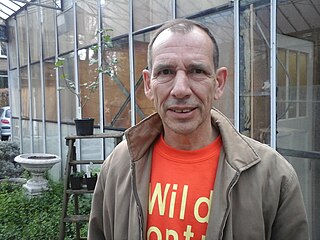Related Research Articles

Municipal Museum Boijmans Van Beuningen is an art museum in Rotterdam in the Netherlands. The name of the museum is derived from the two most important collectors of Frans Jacob Otto Boijmans and Daniël George van Beuningen. It is located at the Museumpark in the district Rotterdam Centrum, close to the Kunsthal and the Natural History Museum.

Albert Carel Willink was a Dutch painter who called his style of Magic realism "imaginary realism".

Richard G. J. Hutten is a Dutch industrial designer, art director, and artist who is active in furniture design, product design, interior design, and exhibition design.
The Museum Card, also known as the Museumkaart in Dutch, is a personal card that grants free entry to approximately 400 museums in the Netherlands for one year. It is available for purchase at many of the larger participating museums or online, with a temporary card issued when purchased from the museum. While most museums offer free entry to Museum Card holders, some museums may charge an additional fee for special exhibitions, but not for general collections.
75B is a design studio based in Rotterdam, Netherlands.
Niek Kemps is a Dutch visual artist and lives and works in Amsterdam and Wenduine, Belgium.
René Daniëls is a Dutch artist.

Han Schuil is a Dutch multimedia artist, who works in a Dutch tradition of compactness and tension in painting.

Berend Strik is a Dutch visual artist working and living in Amsterdam.

Johannes Jacobus (Jan) van der Vaart was an influential Dutch ceramicist from the 20th century, known as founder of the abstract-geometric ceramics in the Netherlands.

Dora Dolz de Herman was a Spanish-Dutch artist, best known for her outdoor ceramic works in the form of chairs and sofas.
Daniël (Daan) van Golden was a Dutch artist, who has been active as a painter, photographer, collagist, installation artist, wall painter and graphic artist. He is known for his meticulous paintings of motives and details of everyday life and every day images.
Axel Erik van der Kraan is a Dutch sculptor, performance artist and graphic artist, also known with Helena van der Kraan as Axel and Helena van der Kraan.
Juul Kraijer is a Dutch visual artist. Her work has been exhibited internationally, and is included in major museum collections such as the Museum of Modern Art, New York City, the Museum of Old and New Art, Tasmania and the Kupferstichkabinett Berlin.
Ineke Hans is Dutch industrial designer.

Ruud-Jan Kokke is a Dutch designer who started his career in the mid-eighties and became known for his furniture, inventive objects, interiors and designs for public space. He has received numerous nominations and awards. He is married to the visual artist and jewellery designer Petra Hartman.

Bernardus Stefanus Henricus (Ben) Zegers is a Dutch visual artist, active as a sculptor and installation artist, and teacher and coordinator at the Gerrit Rietveld Academy.
Thimo te Duits is a Dutch art historian, curator, author and editor, known for his numerous contributions in the field of Dutch applied art.

Hendrik Everhart (Henk) Tas is a Dutch visual artist, working as a sculptor, photographer, graphic artist, and wall painter.
References
- 1 2 "Jeroen Eisinga". IFFR (in Dutch). 2015-09-04. Retrieved 2020-03-29.
- 1 2 3 4 5 "Jeroen Eisinga". Museum Boijmans Van Beuningen (in Dutch). Retrieved 2020-03-29.
- ↑ "Filmkunstenaar Jeroen Eisinga zoekt de grens tussen leven en dood". Den Haag Centraal (in Dutch). 2019-03-20. Retrieved 2020-03-29.
- ↑ "Prix de Rome". Trouw (in Dutch). 1996-10-17. Retrieved 2020-03-29.
- ↑ "Hollandse Meesters in de 21e eeuw - Jeroen Eisinga | Korte Film Poule | EYE". kortefilmpoule.eyefilm.nl. Retrieved 2020-03-30.
- ↑ "40-44-PG". Van Abbe Museum (in Dutch). Retrieved 2020-03-30.
- ↑ Joyce, Tommy (2019-03-03). "Police say what you should do with an upside down sheep". somersetlive. Retrieved 2020-03-30.
- 1 2 3 4 de Lange, Henny (2012-02-18). "Jeroen Eisinga 'Het gaat me om het mysterie van het leven'". Trouw (in Dutch). Retrieved 2020-03-30.
- ↑ "Jeroen Eisinga". Frans Hals Museum (in Dutch). Retrieved 2020-03-30.
- ↑ "Filmkunstenaar Jeroen Eisinga zoekt de grens tussen leven en dood". Den Haag Centraal (in Dutch). 2019-03-20. Retrieved 2020-03-30.
- ↑ "Jeroen Eisinga". Museum Boijmans Van Beuningen (in Dutch). Retrieved 2020-03-30.
- ↑ Pontzen, Rutger (2019-03-19). "Zelden voel je zulke verwantschap tussen werk en omgeving als bij Jeroen Eisinga in De Electriciteitsfabriek ★★★★★". de Volkskrant (in Dutch). Retrieved 2020-03-30.